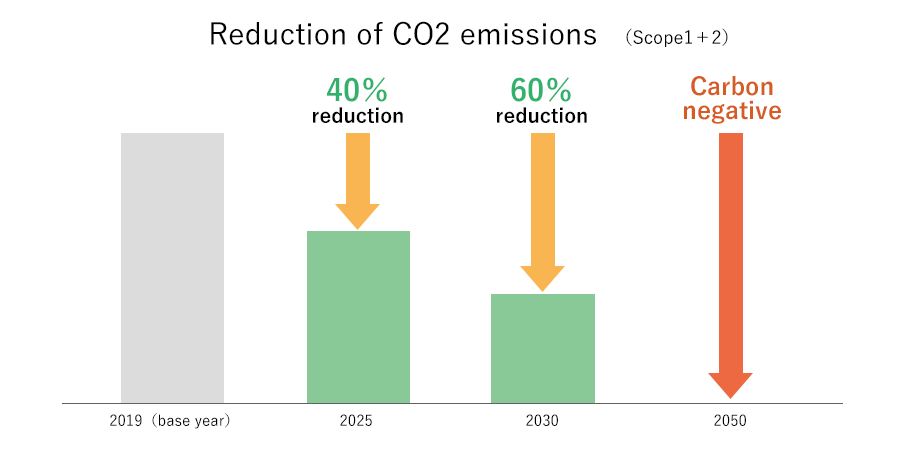Responding to Climate Change
Responding to Climate Change (Disclosures Based on TCFD Recommendations)
The Company has positioned efforts to address climate change as one of our key issues, and the Sustainability Promotion Committee is playing a central role in identifying climate change-related risks and opportunities, assessing their impact on the Company, and considering specific measures to deal with them. The necessary data are being collected and analyzed, and the content thereof are being disclosed in accordance with the information disclosure framework recommended by the Task Force on Climate-related Financial Disclosures (TCFD)*.
*TCFD: Task Force on Climate-related Financial Disclosures; The Group expressed its endorsement of the TCFD recommendations on June 6, 2023.

In disclosing information in accordance with the TCFD recommendations, we refer primarily to the following scenarios:
・Transition Risk and Opportunities "1.5℃": International Energy Agency (IEA) WEO2020 NZE
・Physical Risks and Opportunities "4 ℃ scenario": Intergovernmental Panel on Climate Change (IPCC) AR5
| Governance | Organization's governance around climate-related risks and opportunities |
| Risk Management | The processes used by the organization to identify, assess, and manage climate-related risks |
| Strategy | The actual and potential impacts of climate-related risks and opportunities on the organization’s businesses, strategy, and financial planning |
| Metrics and Targets | Metrics and targets used to assess and manage relevant climate-related risks and opportunities |
1. Governance
We recognize climate-related action as one of our key managerial priorities. For this action, we have a corporate governance system in place with the Sustainability Promotion Committee playing a central role, subject to supervision by the Board of Directors.
<System of Supervision by the Board of Directors>
The Board of Directors monitors the Company’s engagement and target attainment performance with regard to climate-related risks and opportunities, based on reporting from the Sustainability Promotion Committee. It also supervises new measures and targets.
<Sustainability Promotion Committee>
The Group has in place the Sustainability Promotion Committee as an advisory body to the Board of Directors. The Committee is chaired by the Senior Executive Managing Director, COO, who also serves as President and Representative Director of TOHO PHARMACEUTICAL CO., LTD. The Sustainability Promotion Committee is comprised of members from the sales, logistics, and administration functions. It identifies materialities (important issues), including matters related to climate change, and deliberates on our sustainability strategy, which involves, among other things, our actions for the Environment (E), Social (S), Governance (G), and digital transformation (DX). The results are reported to the Board of Directors. Also, with regard to the impacts of climate change on our business, the Committee assesses every year the impacts of climate change on our business, devises measures to cope with them, and sets relevant targets, all in accordance with a policy aimed at minimizing the identified risks and seizing on the opportunities involved.
The Committee also deliberates on target attainment performance and reports the results to the Board of Directors, which oversees it.
<Divisions and Departments Responsible for Climate Action>
The Corporate Communications and Investor Relations Division serves as the secretariat for the Sustainability Promotion Committee. It also serves as a liaison among the divisions and departments concerned and promotes company-wide climate action. Additionally, the Division thrashes out our sustainability strategy, which covers, among other things, matters related to climate change, and advises the Sustainability Promotion Committee.
◆Sustainability promotion system
The Group’s sustainability governance system including climate-related is shown below
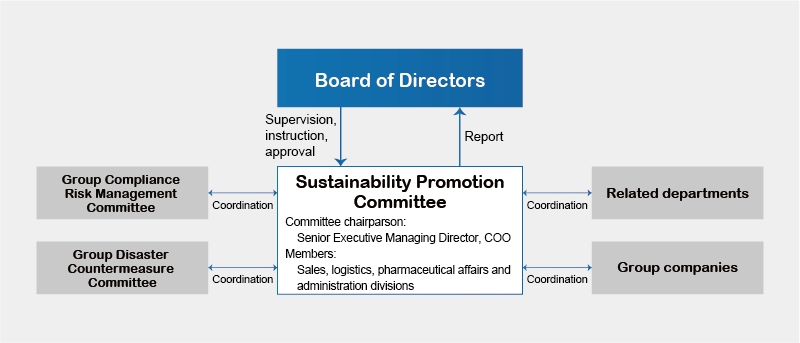
2. Risk Management
The Group has the Risk Management Basic Rules in place to cope with any managerial risks – and situations that may developed into them – and forestall such risks. The Risk Management Basic Rules and the related manual are regularly reviewed for improvement by the Group Compliance and Risk Management Committee. The Committee, chaired by the Representative Director and CEO, regularly engages in the early detection and assessment of risks, the improvement of the system to prevent risks from emerging, and the development of measures to be taken when a risk emerges.
Risks related climate change are under the responsibility of the Sustainability Promotion Committee, which identifies and risks and revenue opportunities arising from related climate change. The Committee reports the results to the Board of Directors in cooperation with the Group Compliance and Risk Management Committee and the Group Disaster Countermeasures Committee.
<Process of Identifying, Assessing, and Managing Risks Related to Climate Change>
The process of identifying, assessing, and managing risks related to climate change involves the following steps:
(1) Risk identification
We identify climate-related risks in accordance with climate-related strategies. We identify the impacts of climate change on our business as well as the risks of natural disasters that may be caused by climate change and the risks of social and other problems. Information on climate-related risks thus identified is shared with the Group Compliance and Risk Management Committee and the Group Disaster Countermeasures Committee.
(2) Risk assessment
We assess the potential impact of the identified risks and consider what measures to take according to their order of importance. Specifically, we consider measures to avert the risks according to their incidence and the extent of their impact. We also appraise the effectiveness of such measures and estimate the costs involved.
(3) Development of climate-related measures
We design climate-related measures.
(4) Target setting
Based on the risk assessment, we set targets to cope with climate risks.
(5) Reporting and monitoring
The Sustainability Promotion Committee regularly reports on performance in relation to the climate targets to the Board of Directors. The Board of Directors supervises the measures to cope with the risks as well as the set targets. It also monitors progress.
(6) Risk review
We continuously review climate risk management plans, the risks to be addressed in times of emergency, and the set targets according to the progress and performance in attaining the targets for the purposes of improvement.
3. Strategy
The Group recognizes sustainability action, including climate action, as one of our key managerial priorities Supply-chain disruptions and reduced capacities to supply drugs due to intensifying natural disasters pose a significant business risk for us – an entity responsible for the distribution of vital and other drugs. They also pose a risk for society at large. The Group is characterized by low Scopes 1 and 2 emissions (emissions released directly from it) and high Scope 3 emissions (emissions released from its supply chains). With this understanding, we have conducted a scenario analysis to assess climate impacts on our business and devise measures to cope with them.
◆Scenario Analysis
For this analysis, the Group referred to scenarios in the IPCC Fifth Assessment Report and IEA WEO2020 NZE, among others. It then considered both a 1.5 ℃ scenario – in which the global temperature rise will be limited to 1.5 ℃ by 2030 (transition scenario) – and a 4 ℃ scenario – in which the global temperature will rise 4 ℃ by 2050 (physical scenario). Based on these two scenarios, the Group identified risks and opportunities for its entire value chain, organized them in terms of the probability and severity of impacts, and qualitatively accessed them.
The Sustainability Promotion Committee plans to assess, among other things, the resilience of our strategy and the need to develop a transition plan while conducting quantitative assessments involving financial impacts. It will make a fresh assessment every time the scope of the target organization is expanded.
◆Global Outlooks We Assume under the 1.5 ℃ and 4 ℃ Scenarios
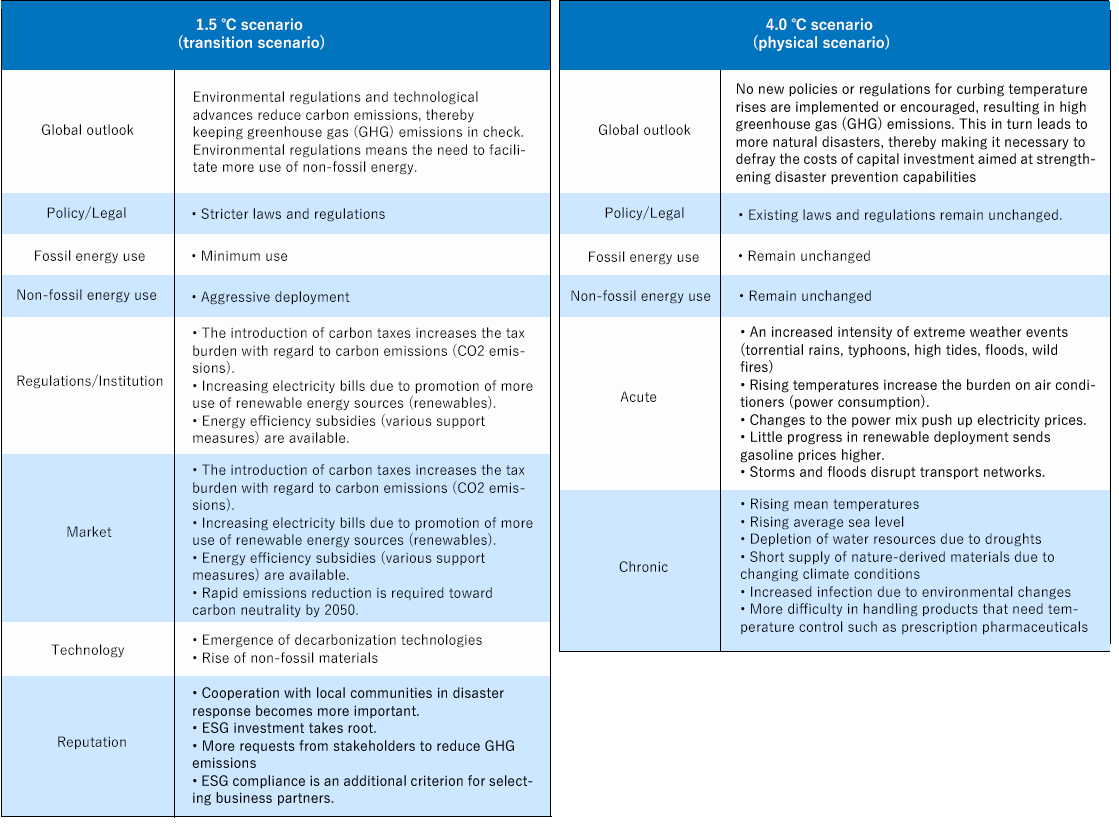
◆Risks and Opportunities
The table below summarizes possible climate-induced events that we assume might affect pharmaceutical wholesaling business in light of the above scenarios. The table considers likelihood and consequence among other factors.
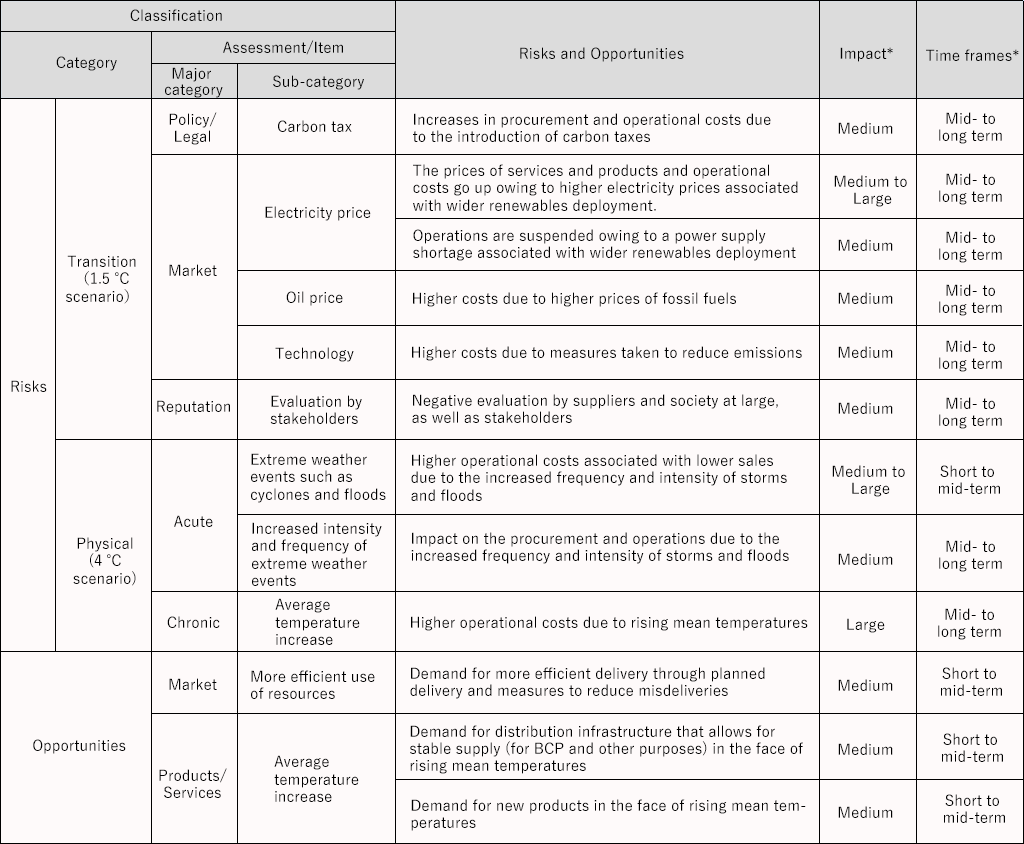
* Consequence is qualitatively assessed in terms of probability and severity of impacts.
* Time frame: short term (up to 2025), mid-term (up to 2030), long term (up to 2050)
4. Metrics and Targets
As part of its efforts to reduce its environmental footprint, the Group uses greenhouse gas emissions (Scope 1, 2, 3) as key indexes to identify the fields with large emissions and the targets for reduction. In light of changes in the social environment, we set our mid- to long-term targets for reduction as far as Scope 1 and 2 emissions, which we directly release. We are also considering specific reduction targets for Scope 3 emissions as well in the belief that efforts to reduce such emissions are also important toward the goal of carbon negative. Going forward, we will work more closely with our suppliers and customers to advance efforts to reduce greenhouse gas emissions.
◆ Actual Scopes 1, 2, and 3 Emissions(unit: t-CO2)
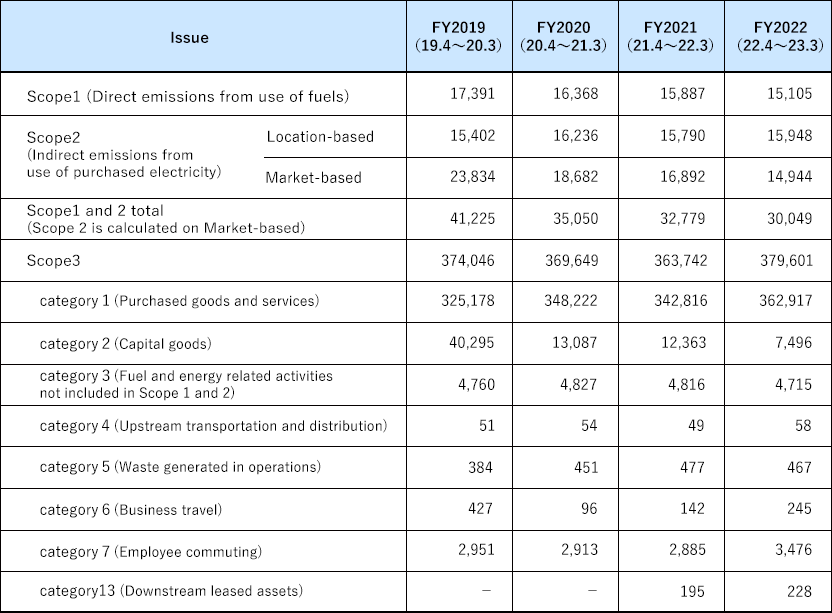
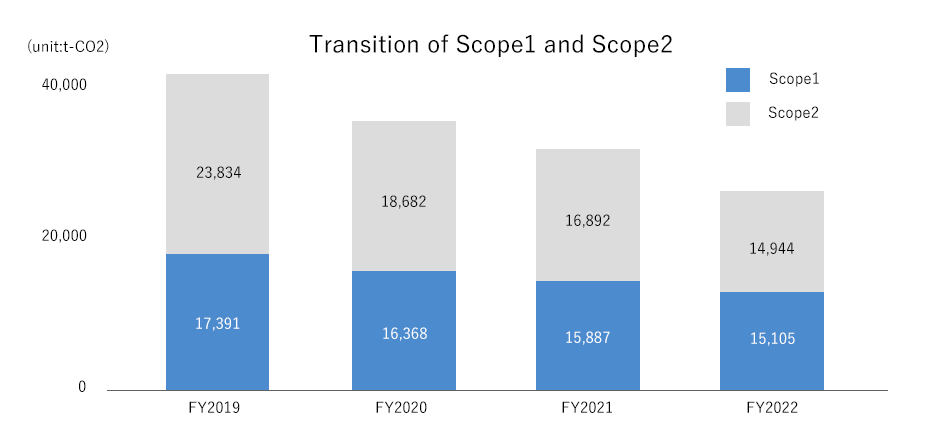
*Scope 2 emissions data is calculated on a market basis.
*Target Organization: TOHO HOLDINGS, TOHO PHARMACEUTICAL, SAYWELL, Kyushu Toho, KOYO,TOHO SYSTEMS SERVICE
◆ Next Steps
The Group will deliberately work on three aspects of the energy issue to help achieve the government goal for carbon. These are saving energy by retrofitting existing facilities and equipment to make them more efficient, creating energy by introducing solar power generation installations, and procuring renewable energy.
(1) Increasing the use of non-fossil energy
・Taking advantage of the planned transfer of our head office functions (office consolidation) to aim to meet 2% of our power demand with renewable energy in fiscal 2024 through the procurement of green power certificates.
・Switching the existing electricity plan to a renewable energy plan at our large distribution centers
・Installation of solar panels and storage battery, etc.
(2) Reducing the use of fossil energy
・Encouraging a modal shift for long-distance transportation
・Shifting from frequent deliveries to planned deliveries
・Replacing our gasoline-powered commercial vehicles with next-generation automobiles
(3) Encouraging energy and resource saving
・Switching to LED lighting
・Promoting a paperless
